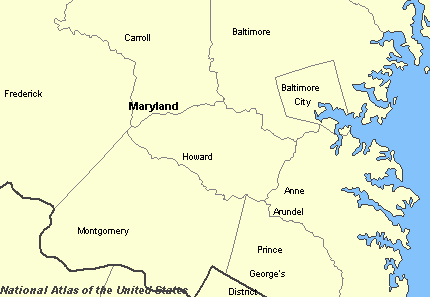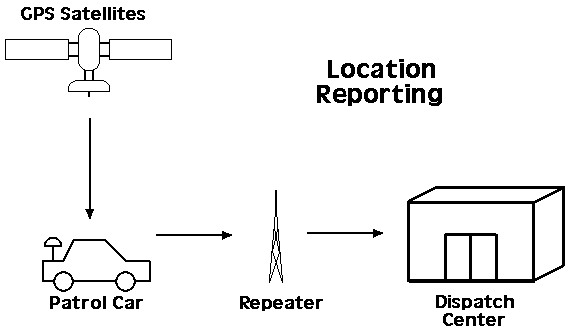| This article first appeared in the April 2003 issue of Monitoring Times. |
Installing a new digital trunked radio system is not easy. Trunking is inherently more complex than conventional radio operation, and adding digital voice to the mix creates a lot of opportunities for problems. Every new system must be tested and checked out before being cleared for full operation, and this process takes time. This month we'll take a look at a few systems that have been in the works for a while and are just coming on-line.
Howard County, Maryland
Howard County is located in Maryland between Baltimore and Washington, D.C. The county's public safety agencies have begun to use a new Motorola Type II ASTRO trunked radio system with mixed analog and digital voice traffic. Unfortunately for scanner listeners, the digital voice is Motorola's proprietary VSELP (Vector-Sum-Excited Linear Prediction) voice encoder-decoder (vocoder) rather than the Project 25 standard IMBE (Improved Multi-Band Excitation). What this means is that a digital scanner will follow conversations and display talkgroups but will be unable to decode any digital voice traffic. Fortunately, most channels are currently operating in analog mode.
Frequencies in use are 857.2375, 857.7375, 866.0375, 866.0625, 866.3875, 866.5375, 866.5750, 866.6875, 866.9625, 866.9875, 867.1125, 867.6375, 867.8000, 868.0375 and 868.0625 MHz.
During the transition phase the county is simulcasting several channels on their old conventional VHF system (PL tone is 103.5):
Fire Dispatch 154.250
Fireground 154.220
Mutual Aid 154.175
Police (North) 159.090
Police (South) 155.115
Car-to-Car 155.370
Police 2 155.595
Montgomery County, Maryland
Just to the west of Howard County lies Montgomery County, perhaps most famous these days as the home of Chief Charles Moose, the head law enforcement officer in the county who headed up the investigation into the D.C.-area sniper shootings last October. During that time the county's new Motorola ASTRO digital trunked radio system was placed into operation, initially providing service to about 130 radios.

The new system uses the Project-25 Common Air Interface (CAI), including the IMBE vocoder. Like Howard County it is a mixed system, supporting both analog and digital traffic. It uses a 3600-baud control channel and is fully trackable on a digital scanner.
The current system has fourteen repeater sites scattered around the county, all operating in simulcast mode. The locations include Bethesda, Boyds, Damascus, Dickerson, Gaithersburg, Germantown, Mount Airy, Olney, Poolesville, Rockville, Silver Spring, Spencerville, Takoma Park and Wheaton.
The system uses the following frequencies: 866.2125, 866.2750, 866.3375, 866.4875, 866.6500, 867.7375, 867.8375, 867.8875, 867.9125, 868.1625, 868.3625, 868.3875, 868.4375, 868.6125, 868.6375, 868.6875, 868.8625, 868.8875 and 868.9375 MHz.
Some identified talkgroups:
3344 Fire Dispatch
3376 Fire Operations
4336 National Naval Medical Center (Bethesda)
13168 Police (South)
13264 Police (North)
A number of talkgroups are encrypted, primarily for police tactical operations.
Phoenix/Mesa, Arizona
The cities of Phoenix and Mesa, Arizona continue to make progress in their effort to install a Project-25 compliant trunked radio network purchased from Motorola. Each city will operate independent systems but will work closely together to provide service across the entire metropolitan area. The initial plan is to support voice operations for as many as 15,000 radios.
Phoenix will carry the bulk of the load, including four separate simulcast sub-systems. Basically, police and fire will each have their own sub-system operating from nine repeater sites, along with West Valley (five sites) and Tempe (four sites). Additional, smaller single-site sub-systems will cover outlying segments of the metropolitan area as part of the Phoenix network. Mesa will have a distinct public safety and city service sub-system transmitting from nine sites.
As with Michigan and other "pure P-25" systems, the Phoenix/Mesa network will use Project-25 standards, including trunking, so the new Uniden digital scanners will not trunk-track these transmissions.
The entire system, as you might imagine, uses an enormous number of frequencies. Rather than list all of them here, I would refer you to a couple of web sites that have the details. Lindsay Blanton operates a very comprehensive trunked radio database at www.trunkedradio.net. You'll need to register in order to use it, but it contains a wealth of frequency and talkgroup information. Many volunteers assist Lindsay in compiling and maintaining the database, and it is constantly being updated.
You will also find frequency listings, derived from the databases of the Federal Communications Commission (FCC), on my web site at www.signalharbor.com. In those listings you will find known and suspected Project-25 frequencies and repeater site locations organized by state.
State of Ohio
Testing continues on the Ohio Multi-Agency Radio Communication System (MARCS), with coverage in more than a dozen central Ohio counties. State Police posts currently using the system include Chillicothe, Circleville, Delaware, Granville, Jefferson, Lancaster, Marion, Mt. Gilead and West. All patrol posts are expected to be using the system by the end of next year.
The MARCS system has the ability to deliver computer data as well as voice traffic, and the Ohio State Police plans to make use of that capability. Ohio State patrol cars will be equipped with laptop computers and a data connection to MARCS, allowing troopers to call up license and vehicle registration information without having to call a dispatcher. It will also provide a link to state criminal and warrant lists, the National Crime Information Center (NCIC), hazardous materials information, and other databases.
Interestingly, MARCS is also expected to relay the location of patrol cars to dispatch centers in real-time. Each car will be equipped with a Global Positioning System (GPS) receiver, which will provide location data to dispatchers (and perhaps other cars) across the radio link. A monitor in the dispatch center will overlay the car's position on a map, making it easier to assign troopers to incidents and to coordinate backup and emergency support.

For the details about the voice side of MARCS, see Tom Swisher's web
site at
www.qsl.net/wa8pyr/marcs.htm
New York, New York
The New York Fire Department has finished a two-year series of investigations and tests of their new, $15 million digital radios and has re-issued them to firefighters. About 3,500 radios were withdrawn from service back in early 2001, just a week after being introduced, when a distress call from a fireman inside a Queens house fire was not heard. Since that time the Department has been using older radios, which may have been partially to blame for the inability of rescue teams to communicate inside the World Trade Center on September 11, 2001.
Several changes have been made to the five-watt UHF radios, which cost more than $3,000 each. Besides knob and speaker changes, and the addition of an emergency button, the most interesting change is the decision to revert back to analog voice. Even though fire officials say it was a training issue, firefighters did not like the echoes and other audio artifacts from the digital voice radios. They were also troubled with the half-second speech delay imposed by the relatively long vocoder encoding and decoding process. Even though the radios are capable of digital operation, most channels are strictly analog only.
Since the radio reissue occurred so recently, scanner listeners are still working out the proper frequency assignments. Fireground handheld radios apparently have sixteen channels assigned, most running in analog mode. These frequency assignments reportedly have a bandwidth of 6.25 kHz, which is narrow compared to the usual 12.5 kHz spacing.
1 Tactical 486.1125
2 Command 485.1875
3 Tactical 2 486.2625
4 Channel 4 487.2625
5 Channel 5 487.1375
6 Channel 6 485.2625
7 Channel 7 486.1375
8 Channel 8 485.0625
9 Channel 9 (Digital) 486.01875
10 Emergency Medical Services 487.4875
11 In-Building Repeater 483.0125
12 In-Building Repeater (Digital) 483.00625
13 Mobile Repeater 484.7625
14 Subway Repeater 460.575
15 Subway Repeater 460.625
16 Emergency 486.7375
This is preliminary information -- please e-mail me with updates!
Tracking 9600-baud systems
Dan,I read your column every month and I wanted to let you know that I found your February 2003 column to have very valuable information concerning Michigan's APCO-25 radio system. This is the first I have heard that Michigan's system is 9600 baud and will not be receivable on the new Uniden scanners being introduced. I was considering purchasing one but will wait until Uniden possibly introduces a scanner compatible to Michigan's system. I enjoy your column and think you're doing a fine job.
Thanks, Les in Davison, MI
Michigan's statewide APCO Project 25 system has been covered in Tracking the Trunks several times in the past. Michigan elected to use the Project 25 standard trunking protocol, which specifies a control channel signaling protocol operating at 9600 baud. The new Uniden scanners, the BC250D and BC785D, are only capable of trunk tracking systems that use a different, 3600-baud control channel. However, with the APCO-25 add-on BCi25 card, the scanners are able to decode the voice portion of digital transmissions. By operating the scanner in conventional rather than trunked mode, a listener could hear the activity but might have difficulty following an entire conversation.
Understandably, many scanner listeners in areas served by 9600-baud systems are reluctant to spend upwards of $700 on a scanner that will not follow conversations. However, for those willing to wait, there may be a solution before the end of the year.
Radio Shack digital scanner?
Now that the new Uniden digital trunk tracking scanners are on the market, the rumor mill has begun to discuss the possibility of another digital scanner becoming available in the near future.
More than a year ago Radio Shack indicated they were working on an add-on product that would decode digital trunked transmissions. Beyond that announcement in a newspaper interview, not much has been heard from the folks in Fort Worth - until recently. Apparently Radio Shack and GRE are working on a handheld scanner that will successfully monitor APCO-25 systems. Rumor has it that the scanner will also track systems using 9600-baud control channels as well as 3600-baud systems. The new scanner is expected to be in stores in time for the Christmas 2003 shopping season and will probably have a price tag of somewhere around $500.
Scanner Software
Mike Agner, KA3JJZ, writes in to remind readers that he maintains a very
comprehensive list of software packages for a variety of scanners at
http://www.strongsignals.net/access/content/software.html
The page is separated into sections, including numerous entries for trunk tracking support software for both analog and digital scanners.
Software packages that support the new Uniden digital scanners are available now, and the list continues to grow for both shareware and commercial products. The general opinion seems to be that the Escanner software that comes with the scanners isn't worth the effort to install. It has very few useful features and is difficult to remove after you decide you don't want it. Alternatives include Trunk Manager, which reportedly works well with the BC250D (and most likely the 785D as well), and Butel's ARC250. I'm sure there are other worthwhile software packages out there as well.
That's all for this month. I welcome your electronic mail about digital trunking, scanner software, or any other radio topic at danveeneman@monitoringtimes.com, and as always more information is available on my website at www.signalharbor.com. Until next month, happy monitoring!